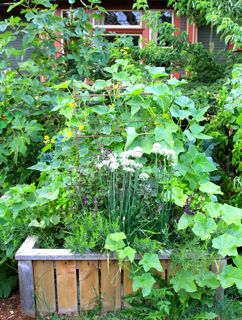Making the most of your vegetable garden!
 There are several ways to make the absolute most of your vegetable garden plot. Succession planting will give you a much longer season of harvest and inter-planting will help maximize space and make room for more plants and less room for weeds and pests.
There are several ways to make the absolute most of your vegetable garden plot. Succession planting will give you a much longer season of harvest and inter-planting will help maximize space and make room for more plants and less room for weeds and pests.
Succession planting – Cool or short season crops can be planted very early in the Spring, starting in February then rounds of successive plantings continue on into the Fall for continual harvests. During mild winters here in Portland we can have harvests of vegetables almost year round with just a little consideration of planting times.
The first step in developing a succession garden is to make a list of which vegetable you want to grow. Seed packets, gardening books or local University extension web sites will have information on the best time to plant each crop. Check for the dates to maturity, spacing needs, sun requirements and frost tolerance.
Make a planting schedule with the best dates for each plant. You can simplify the process by breaking it down into Spring, Summer and Fall plantings. Or you can go nuts with weekly additions like fast growing lettuces or radishes.
You can pick up a copy of our free planting guides at thicket for tips on what to plant when. Some examples are:
Early planting – peas, arugula, brussels sprouts, carrots, kale, broccoli, beets, greens, cilantro, onions, leeks.
Midseason planting – beans, corn, peppers, tomatoes, cucumbers, squash, eggplant, melons
Late planting – Beet, broccoli, brussels sprouts, cabbage, cauliflower, celery, chive, collard, endive, kale, shallots, fava, garlic.
Interplanting
Interplanting is a great way to make more room in your garden. The process involves planting crops in the same place at the same time. Many plants can thrive in much tighter quarters that the seed packet suggests as long as you have an understanding of the plants needs and growth cycle. And pests are usually crop specific so mixing up plant families in the garden can help keep them at bay.
Staggering harvest time is a simple process. You might plant a very quickly growing radish, beet or arugula in front of something like a pepper or tomato which will take much longer to mature. You will harvest the fast crops by the time the slow crops need all that space.
Light requirements vary from plant to plant. Lettuces, spinach and celery need less light so place them behind taller crops like tomatoes, peppers or beans.
Nutrient needs can also vary. You can plan your garden so that heavy feeders are grouped together for easy fertilization. Examples are broccoli, cabbage, cucumbers, eggplant, squash and tomato.
Root depth can also be a consideration. Shallow rooted veggies like greens, alliums and radishes wont compete as much for water and nutrients if planted with deep rooted beans, squash, pumpkins or tomatoes.
Compact plantings of lettuces, greens, onions and beets will produce to many plants in one row but you can thin the plants and eat them as micro greens while you are waiting for the rest to reach maturity.
Happy planning and happy eating!